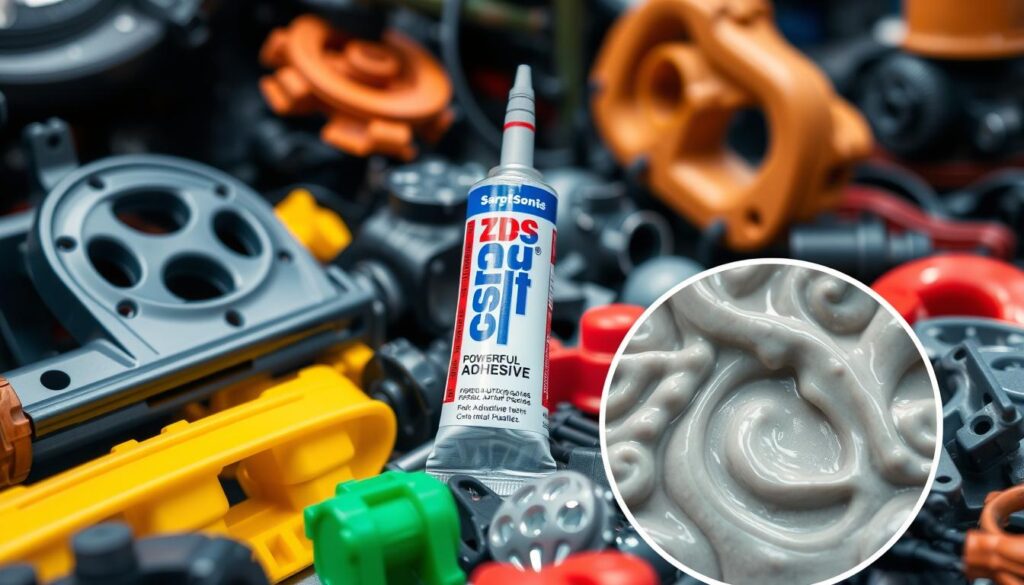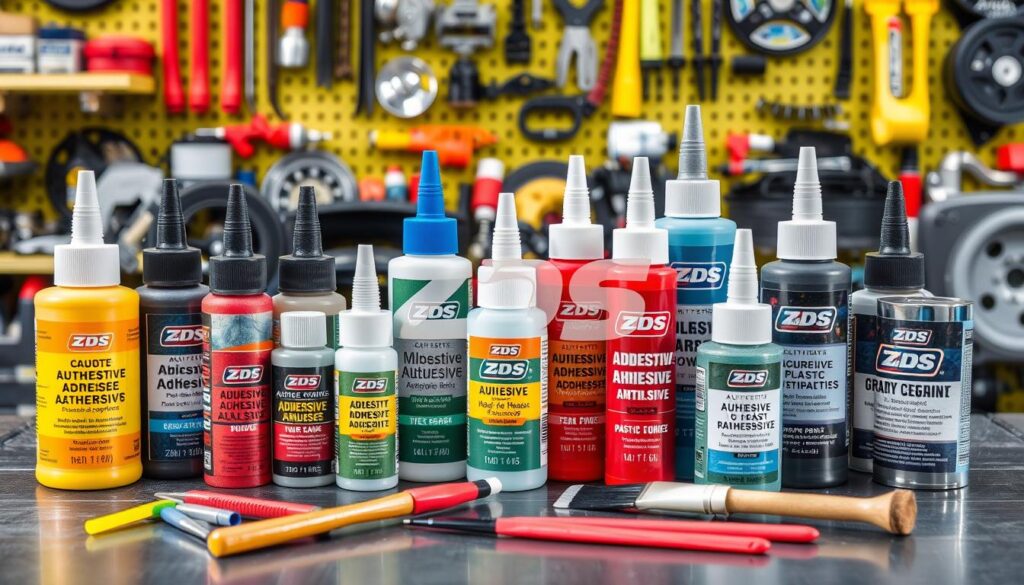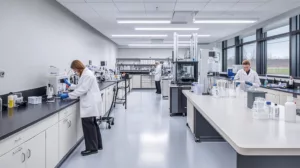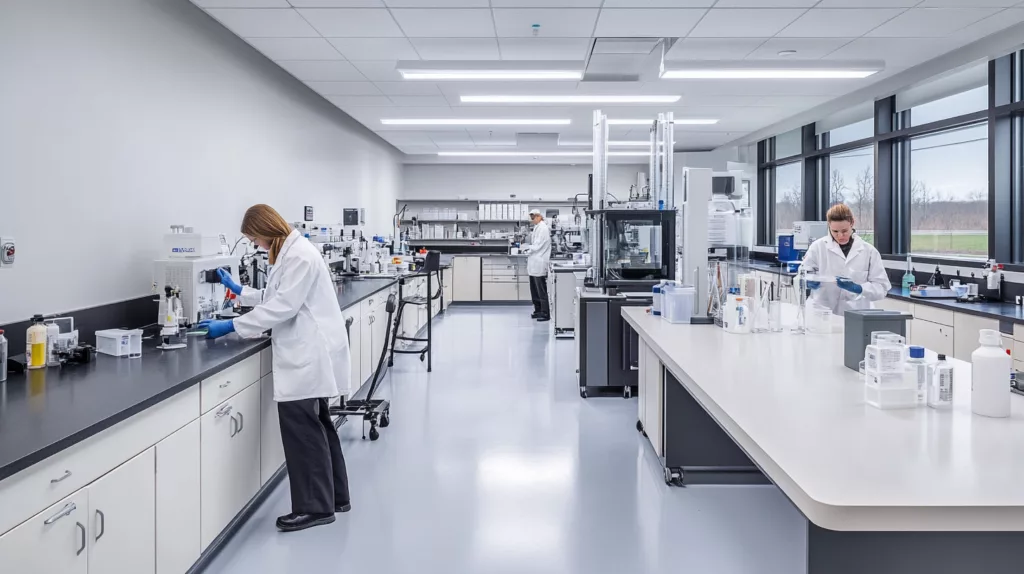Choosing the right adhesive is vital for car component repair. Plastic parts see a lot of use and can get damaged easily. This includes anything from a cracked bumper to a loose trim inside the car. Getting a specialized adhesive that’s made for durable plastic bonding is key. In this article, we discuss the importance of the best adhesive for plastic car parts. This ensures repairs last long and keep your vehicle in good shape.
Key Takeaways
- Importance of using specialized adhesives for plastic car parts.
- Scenarios where durable plastic bonding is crucial.
- Benefits of reliable adhesives in car component repair.
- Overview of top brands offering automotive plastic adhesives.
- Long-term advantages of using the best adhesive for repairs.
Introduction to Automotive Plastic Adhesives
In the world of automotive maintenance and repair, adhesives are key. They are crucial for keeping parts of the vehicle together. Automotive plastic repair adhesives and plastic bonding adhesives for cars ensure the car’s structure stays sound.
Automotive plastic adhesives bond strongly, enduring tough conditions. They’re used on bumpers, dashboards, and both inside and outside parts. The adhesives are made to handle heat, shakes, and chemicals well.
New technology has made adhesives stronger and easier to use. They come in liquids, gels, and tapes. This makes them versatile for different repair needs. Using quality plastic bonding adhesive means repairs last longer, not just quick fixes.
Understanding these adhesives helps owners and repairers choose wisely. Knowing their features and uses leads to better repair outcomes. It keeps vehicles durable and running smoothly.
What to Look for in an Automotive Plastic Adhesive
Choosing the right adhesive for automotive plastics requires thought. It’s crucial to ensure it performs well and lasts long. The success of an adhesive is linked to its features.

Key Characteristics of an Effective Adhesive
Good adhesives share several qualities, such as withstanding heat and being flexible. They must handle different temperatures without their bond weakening. Being flexible means they can take a hit without breaking.
How fast an adhesive cures, or sets, is also key. A quicker cure means faster repairs, getting cars back in use sooner. Plus, the adhesive’s chemicals must not harm automotive plastics while providing a strong hold.
Common Applications
Adhesives in automotive uses are quite handy. They’re used to stick on body panels, hold cables, and repair hoses. Selecting a robust adhesive is vital for the car’s look and structure. With these traits in mind, users will find adhesives that offer lasting repairs.
Top Brands for Automotive Plastic Adhesives
When looking for a good plastic adhesive for cars, quality is key. Many brands are out there, each with its own strengths and special mixes. Let’s explore the big names in plastic adhesives that stand out in the field.
ZDS™ Automotive Adhesives
ZDS™ adhesives are a top pick for cars. They’re known for lasting a long time and sticking really well. These adhesives can handle almost anything cars go through. They stay strong through temperature changes and keep parts firmly together for the long haul. For a high-end solution, ZDS™ is worth considering.

Other Leading Brands
Besides ZDS™, other brands are also at the top in quality. 3M, Loctite, and Permatex are big names in this space. They make a variety of adhesives for different car needs. These brands are known for creating strong bonds and reliable results:
- 3M: 3M is celebrated for its cutting-edge adhesives. Professionals globally trust them for their dependability and adaptability.
- Loctite: Loctite adhesives are known for their strength and versatility. They’re a preferred choice for a broad range of uses.
- Permatex: Permatex makes adhesives that are easy to use. Both hobbyists and pro mechanics appreciate their effectiveness.
By opting for these leading brands, you’re choosing reliable and durable products. They’re ideal for plastic parts in cars.
Benefits of Using Automotive Grade Plastic Adhesives
Automotive-grade plastic adhesives stand out from non-specialized types. They resist oils, chemicals, and extreme temperatures well. This helps your car’s repairs last longer. So, you don’t have to fix things often, saving money over time.
These adhesives are reliable for the auto industry. They handle the stress of driving, like vibrations and impacts. Even when it’s really hot or cold, these adhesives keep things stuck together.

Choosing automotive-grade adhesives means your repairs meet high standards. Your car stays safe without quality compromises. They are tested to tough industry standards. This makes your car’s repairs last longer and stay reliable.
| Benefit | Explanation |
|---|---|
| Resistance to Oils and Chemicals | Automotive-grade adhesives are designed to withstand rigorous exposure to automotive fluids, ensuring lasting repairs. |
| Extreme Temperature Resistance | These adhesives can endure extreme hot and cold conditions without losing bonding strength, making them ideal for diverse climates. |
| Structural Integrity | They maintain strong bonds under high-stress conditions, ensuring vehicle safety and performance. |
| Compliance with Industry Standards | Designed and tested to meet stringent automotive industry regulations, guaranteeing reliability and safety. |
Automotive Adhesive for Plastic Parts: A Comprehensive Guide
Repairing or maintaining auto plastic parts? The adhesive you choose matters a lot. This guide dives deep into how to pick the right one for your car’s plastic parts. Understanding why automotive-specific adhesives are important ensures repairs last longer and are more effective.

Why Choose Automotive-Specific Adhesives?
Automotive adhesives are made unique for cars. They handle car parts’ stress like vibrations, temperature changes, and chemicals well. Picking the right one boosts repair durability.
- Performance: They pass tough tests, ensuring they work great under different conditions.
- Compatibility: These adhesives bond well with many auto plastics, making them less likely to fail.
- Safety: They meet safety standards, reassuring DIY fans and professionals.
Long-Term Benefits
Choosing auto-specific adhesives brings big long-term gains. They bond stronger and more securely than general adhesives. They’re made specifically for vehicle plastics, reducing chances of the bond weakening over time.
“By utilizing automotive-specific adhesives, car owners can extend the lifespan of their vehicle’s plastic parts and maintain their aesthetic appeal.”
These adhesives also endure harsh weather, from extreme heat to cold. This reliability is key for cars in different climates. Plus, picking the right adhesive with a complete guide avoids frequent fixes, saving time and money.
| Aspect | General-Purpose Adhesives | Automotive-Specific Adhesives |
|---|---|---|
| Durability | Moderate | High |
| Compatibility | Limited | Extensive |
| Environmental Resistance | Low | High |
How to Prepare Plastic Parts for Adhesion
To get a strong bond, proper prep is key when using adhesives on plastic parts. Good adhesive surface preparation helps the bond last longer and work better. We’ll cover the top methods for cleaning plastic for adhesion and the surface treatments that work best.
Cleaning and Surface Preparation
For adhesive bonding, the surface must be clean. Dirt, grease, and other impurities can ruin the bond’s strength. To prep the surface well for adhesive surface preparation, follow these steps:
- Remove Physical Debris: Begin by wiping off any dust or dirt with a clean cloth.
- Degrease the Surface: Use isopropyl alcohol or similar solvents to remove grease and oil.
- Dry the Area Thoroughly: Make sure the plastic is fully dry before using the adhesive.
Surface Treatments
There are also specific treatments to improve adhesion beyond just cleaning. These methods include:
- Sanding: Light sanding creates a rough texture on the plastic, which improves adhesive grip.
- Priming: A special primer for plastics can greatly increase adhesion.
- Heat Treatment: Sometimes, a little heat can make the plastic’s surface better suited for adhesives.
By following these steps for cleaning plastic for adhesion and applying the right surface treatments, you create the best conditions for a strong and lasting bond.
Step-by-Step Guide: Applying Adhesive to Plastic Car Parts
Getting a perfect bond on plastic car parts requires focus and the correct supplies. This part is a detailed adhesive application guide for both hobbyists and experts.
Tools and Materials You’ll Need
To start on your plastic panel bonding, you first need to collect the right tools and materials. This step is vital for a good result:
- Plastic adhesive (make sure it is for car use)
- Cleaning solution (to prep the surface)
- Applicator gun
- Protective gloves
- Clamps or weights (to keep parts together as the glue dries)
- Sandpaper (to roughen surfaces)
Application Techniques
With all tools and materials ready, follow these steps for strong adherence:

- Surface Preparation: Clean the plastic parts well with a cleaner to take off any dirt that could mess up the bond. Sand the surfaces lightly to make them rough. This helps the glue stick better.
- Adhesive Application: Put the glue in the gun. Spread a smooth line of glue on the parts that need to stick together. Make sure the line is neat and covers the whole area that needs glue.
- Joining the Parts: Put the plastic pieces together carefully. Press them hard. Use clamps or weights to keep them in place as the glue sets. Check the glue’s drying time to make sure it sticks well.
- Inspection: After the glue is completely dry, take off the clamps and check the bond. Make sure there are no loose parts. If necessary, add more glue to make the bond stronger.
By using this adhesive application guide and learning these plastic panel bonding techniques, you’ll be able to fix your vehicle so it looks great and lasts long.
Best Adhesive for Plastic Car Bumpers and Panels
Choosing the right adhesive is key for fixing plastic car bumpers and panels. The best one keeps the repair durable, flexible, and strongly stuck together. These qualities make the repair last a long time.
Quality adhesive for car parts firmly holds them together. It also keeps their look and performance like new. With so many options out there, picking one made for cars is important.
The table below shows some top adhesive recommendations for bumpers and panels:
| Brand | Adhesive Type | Key Features | Application |
|---|---|---|---|
| 3M | Automix EZ Sand Flexible Parts Repair | Fast curing, sandable | Bumpers and flexible parts |
| Plexus | MA300 | High strength, quick set | Structural repairs |
| Loctite | PL Premium | Water-resistant, non-shrink | Panels and trims |
| J-B Weld | Plastic Weld | High tensile strength, versatile | All plastic parts |
These adhesives are great for plastic car bumpers and panels. They can handle impacts and the weather. Using them the right way makes repairs look professional. It’s a good choice instead of getting new parts.
Automotive Plastic Welding Adhesive vs. Traditional Adhesives
There’s ongoing debate about whether to choose automotive plastic welding adhesive or traditional adhesives for car repairs. Each one has its own good points and not-so-good points. They fit different repair jobs and what people want.
When to Use Plastic Welding Adhesive
Using an automotive plastic welding adhesive is smart for needing strong, lasting connections. It works best for:
- High-stress areas
- Components that move a lot
- Repairs where you want the fix to look seamless
Pros and Cons
| Adhesive Type | Advantages | Disadvantages |
|---|---|---|
| Automotive Plastic Welding Adhesive |
|
|
| Traditional Adhesives |
|
|
Knowing when to pick an automotive plastic welding adhesive over a standard glue can really make repairs better. It helps the repair last longer and stay stronger.
Strong Adhesives for Automotive Plastics: Recommendations
Choosing the right adhesive is crucial for your car’s plastic repairs. It ensures the parts last long and stay sturdy. Many strong plastic adhesives are out there, each made for different repair jobs. Below, we’ll share some top picks suitable for various car repair needs.
| Brand | Product Name | Strength | Application |
|---|---|---|---|
| ZDS™ | ZDS™ Bond-Strength 9000 | High | Bumpers, Panels |
| Loctite® | Plastic Bonder | Medium | Small Parts, Trim |
| 3M™ | Super Fast Repair Adhesive | Very High | Body Panels, Trim |
Our recommended adhesives provide strong plastic bonds for all repair types. They ensure reliable, long-lasting results for different car parts.
Case Studies: Successful Plastic Repairs Using ZDS™ Adhesives
Discover how ZDS™ adhesives have played a crucial role in plastic repairs. Through these case studies and testimonials, learn about the positive impact and high satisfaction levels among customers. This shows how innovative adhesives can make a difference.
Real-World Examples
ZDS™ adhesives have shown excellent results in the auto industry. Mechanics from different repair shops have shared their success stories:
- Repair of a cracked bumper: In New Jersey, a garage fixed a severely cracked bumper on a premium sports car using ZDS™ adhesives. They restored the car’s strength and look.
- Fixing damaged panels: A California body shop achieved perfect repairs on various car models’ plastic panels with ZDS™ adhesives. They noted it was quicker than old methods.
- Restoring plastic trims: A Texas specialist used ZDS™ adhesives for plastic trims with easy and durable results. This ensured the customers were happy with their repairs.
Customer Testimonials
Many customers have expressed their satisfaction with ZDS™ adhesives:
“I thought my bumper was a lost cause. But ZDS™ adhesives made my car look like new!” – Alex R., New York
“ZDS™ adhesives saved me time and money on my car’s plastic panels. The results were fantastic.” – Rachel T., Florida
“I’m thrilled with how ZDS™ adhesives fixed my car’s plastic trims. The results were perfect.” – Michael L., Texas
Conclusion
As we wrap up our deep dive into automotive adhesives for plastic parts, the importance of choosing the right adhesive shines through. It ensures durable and high-quality repairs. We’ve shared insights to help you pick the perfect adhesive, focusing on durability, compatibility, and how easy it is to apply. Brands like ZDS™ Automotive Adhesives highlight the care and knowledge needed to create top-notch products.
Knowing how to prepare surfaces properly and apply the adhesive step by step is key. These steps help you fix cars’ plastic parts effectively. Plus, by highlighting the perks of car-specific adhesives, we see their long-term worth. This tells us spending on quality adhesives is crucial for keeping your car’s look and strength.
Overall, if you stick to the solid car adhesion strategies we’ve discussed, you’re set for auto maintenance tasks. The best products and methods not only make repairs sturdy but also keep your vehicle’s plastic parts lasting longer. We aim that these final insights on automotive adhesives guide your repair works towards success.
FAQ
What is the best adhesive for plastic car parts?
The top choice is automotive grade plastic adhesive. It creates a durable bond. It’s made for the tough conditions in cars.
What are the key characteristics of an effective automotive plastic adhesive?
A good automotive plastic adhesive needs to resist high temperatures. It should also be flexible, cure quickly, and fight off chemicals. These qualities make it perfect for car use.
When is it necessary to use an automotive plastic welding adhesive?
Use it when strong, lasting bonds are needed. Like for structural parts or high-stress areas. It makes plastic parts stick together well.
Why should I choose an automotive-specific adhesive over a generic one?
Automotive-specific adhesives handle cars’ tough demands better. They resist chemicals, oils, and extreme heat well. This means they last longer and are more reliable than generic ones.
Which top brands are known for high-quality automotive plastic adhesives?
ZDS™ stands out for its top-notch adhesives. Other brands are also good, offering strong, lasting bonds for car repairs.
How should I prepare plastic parts before applying adhesive?
First, clean the parts well to remove dirt and oil. Sometimes, you also need to treat the surface. This makes sure the adhesive sticks well.
What are some recommended adhesives for repairing plastic car bumpers?
Look for adhesives made for bumpers. They’re made to be flexible and resist impacts. This makes them great for fixing bumpers.
What tools and materials are needed for applying adhesive to plastic car parts?
You need the adhesive, tools for applying it, cleaners, and surface treatments. Always follow the adhesive maker’s directions.
What are the long-term benefits of using automotive grade plastic adhesives?
They resist chemicals, oils, and extreme heat, making repairs last. This helps keep car parts in good shape longer, saving you repair time and money.
Are there any case studies demonstrating successful repairs with ZDS™ adhesives?
Yes, many studies show how well ZDS™ adhesives work. These stories and feedback from customers prove their strong bonds work, keeping customers happy.











